
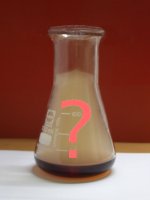

Riddle: Copper (II) and nitrite
In this experiment a coordination complex of copper (II), probably with nitrogen dioxide, is prepared. This is a fairly unstable complex with a beautiful blue/indigo color. The coordination complex requires acid, chloride, nitrogen dioxide and copper (II). Leaving out one of these compounds does not result in formation of the deep blue compound.
The question, raised during these experiments is: What is the exact nature of the blue coordination complex? Is it a coordination complex of copper with NO2? What is the role of the chloride in this complex?
![]()
![]() Required
chemicals:
Required
chemicals:
-
copper sulfate pentahydrate
- dilute sulphuric acid, approximately 20% by weight
- sodium chloride
- sodium nitrite
![]() Required
equipment:
Required
equipment:
-
test tubes
- stopper
![]() Safety:
Safety:
-
In this experiment a small amount of NO or NO2 is prepared. These gases are insidiously toxic. Breathing these gases only results in minor direct irritation or suffocation. The real effect is delayed by several hours. Because of the low warning level, absolute care must be taken not to inhale any of these gases. The amounts produced in this experiment are quite small, but in order to be on the safe side it is recommended to perform this experiment only in a good fume hood or outside!
- Sulphuric acid (20%) is corrosive.
- Sodium nitrite is toxic and may irritate the skin. In contact with acids, the gases NO and/or NO2 are released.
- Copper sulfate is moderately toxic.
![]() Disposal:
Disposal:
-
Copper compounds are moderately toxic for the environment. If more than just a single spatula of copper sulfate is used in the experiments, then it is best to pour the solutions in excess solution of sodium carbonate in order to avoid pressure buildup during storage of the waste. When fizzling stops, the solutions can be kept in a plastic bottle, until they are brought to a waste processing facility. If very small amounts are used, then the solutions can be flushed down the drain by mixing them with copious amounts of water.
![]()
Procedure for preparation of blue complex
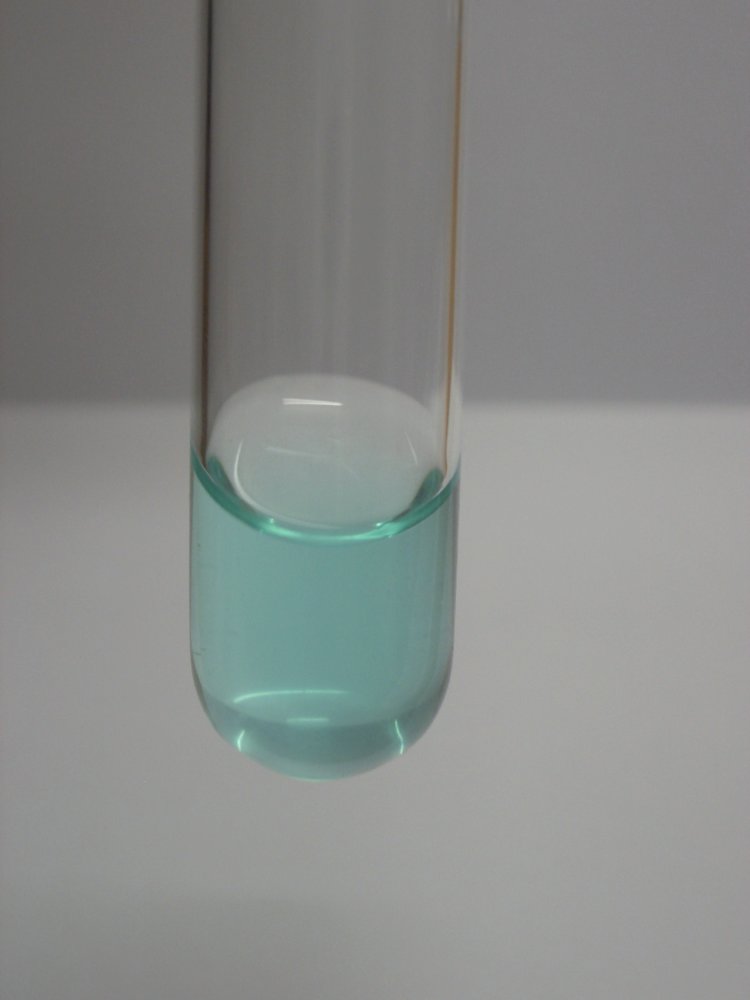 Add
a small spatula full of copper sulfate to a few ml of dilute sulphuric acid.
Dissolve all the solid. A clear light blue solution is obtained.
To this solution add a spatula full of sodium chloride. When this sodium
chloride dissolves, then the liquid slightly shifts color. Its color shifts from
sky-blue to cyan. This is due to formation of a complex of copper and chloride,
probably CuCl42-.
Add
a small spatula full of copper sulfate to a few ml of dilute sulphuric acid.
Dissolve all the solid. A clear light blue solution is obtained.
To this solution add a spatula full of sodium chloride. When this sodium
chloride dissolves, then the liquid slightly shifts color. Its color shifts from
sky-blue to cyan. This is due to formation of a complex of copper and chloride,
probably CuCl42-.
Add a spatula full of sodium nitrite to this solution. This results in fizzling of the solution and the solution turns deep blue. This deep blue color is assumed to be a coordination complex with copper(II), chloride and nitrogen dioxide. This complex is not very stable. It slowly decomposes and the deep blue color slowly fades. The presence of chloride is important for this experiment! If sodium nitrite is added to an acidified solution of copper sulfate, without chloride, then the color of the solution only changes marginally (the sky blue changes to a somewhat dull blue).
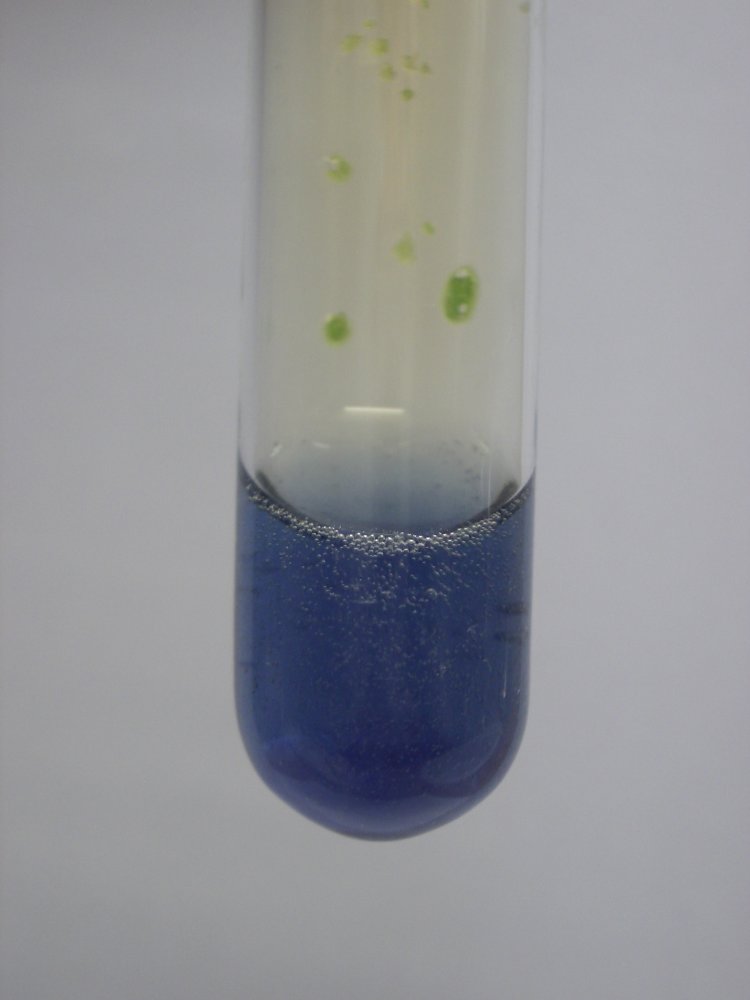 The
figure at the right shows the contents of the test tube, a few seconds after the
solid sodium nitrite is added. The liquid is deep blue and
still bubbling a little bit. The green specks on the glass are solid pieces of
sodium nitrite, which form a green compound with the acidic copper (II)
solution, which was sticking on the glass, before the sodium nitrite was added.
The
figure at the right shows the contents of the test tube, a few seconds after the
solid sodium nitrite is added. The liquid is deep blue and
still bubbling a little bit. The green specks on the glass are solid pieces of
sodium nitrite, which form a green compound with the acidic copper (II)
solution, which was sticking on the glass, before the sodium nitrite was added.
The test tube with the deep blue liquid was allowed to stand for a while, loosely stoppered. After a few minutes, the stopper was removed, allowing fresh air to enter the test tube. This results in the following:
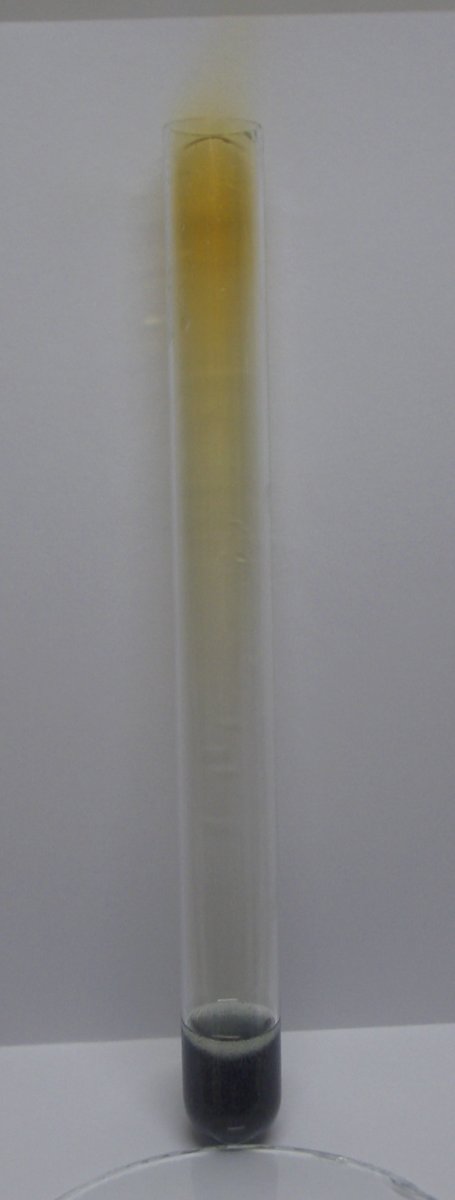 Inside
the test tube colorless nitrogen monoxide (NO) was formed. When the stopper was
removed, then the NO reacts with oxygen from the air, resulting in formation of
brown nitrogen dioxide (NO2).
In the meantime, the liquid already has changed color somewhat. The color is
less brilliant. When the liquid is swirled around in the test tube, by keeping
it almost horizontal and allowing the liquid to come in contact with the brown
NO2
then the deep blue complex is formed again.
Inside
the test tube colorless nitrogen monoxide (NO) was formed. When the stopper was
removed, then the NO reacts with oxygen from the air, resulting in formation of
brown nitrogen dioxide (NO2).
In the meantime, the liquid already has changed color somewhat. The color is
less brilliant. When the liquid is swirled around in the test tube, by keeping
it almost horizontal and allowing the liquid to come in contact with the brown
NO2
then the deep blue complex is formed again.
The deep blue complex is a complex, containing copper (II), chloride and some nitrogen compound, possibly either HNO2 or NO2. This can be concluded from the fact, that the complex is formed immediately under the following conditions:
• adding sodium nitrite to the acidic solution with copper (II) and chloride;
• bringing an acidic solution with copper (II) and chloride in contact with NO2.
![]()
Decomposition of the deep blue complex
A new solution of copper sulfate and sodium chloride in dilute sulphuric acid is prepared. To this, a spatula of solid sodium nitrite is added and the liquid is observed for several minutes. Below a sequence of pictures is given, just before adding the sodium nitrite and after adding this, in intervals of 2 minutes,
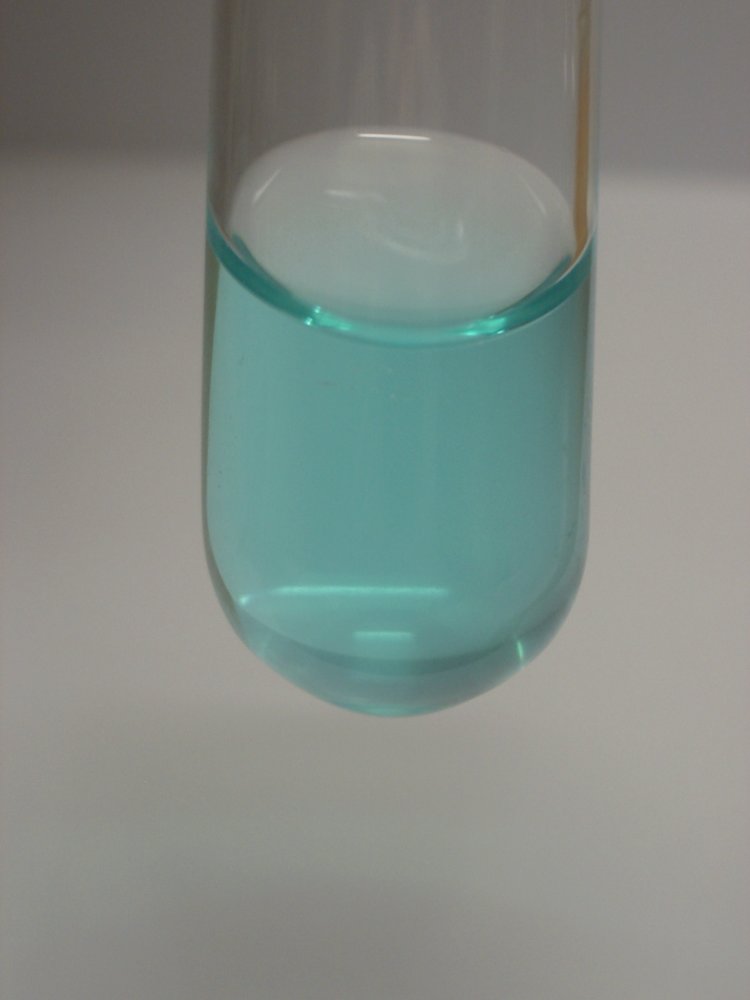
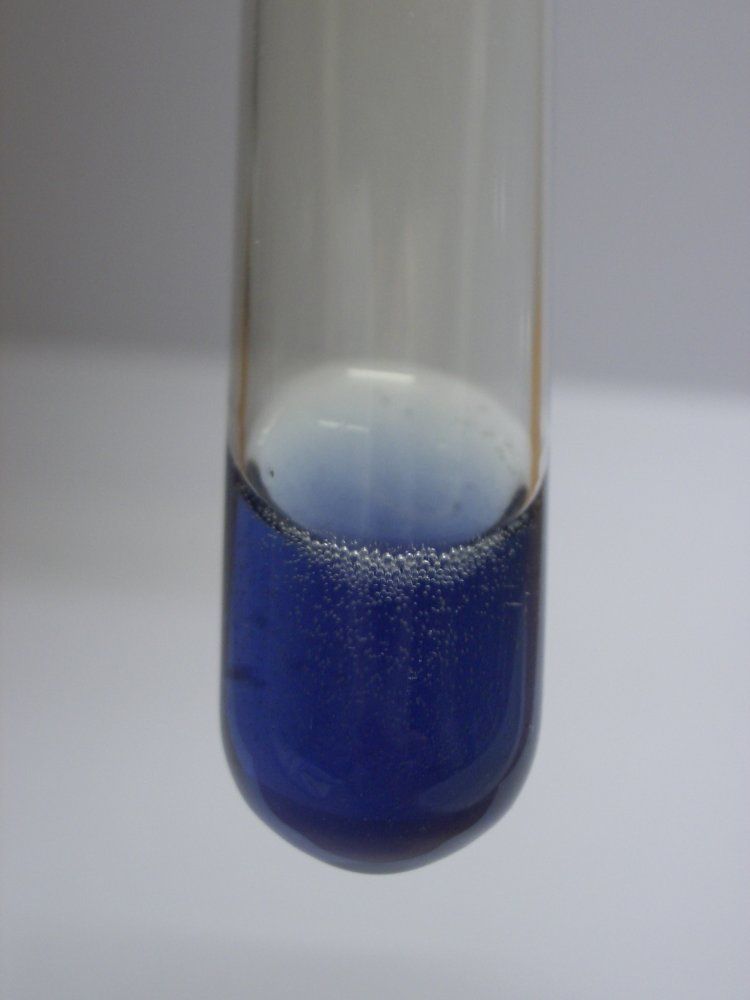
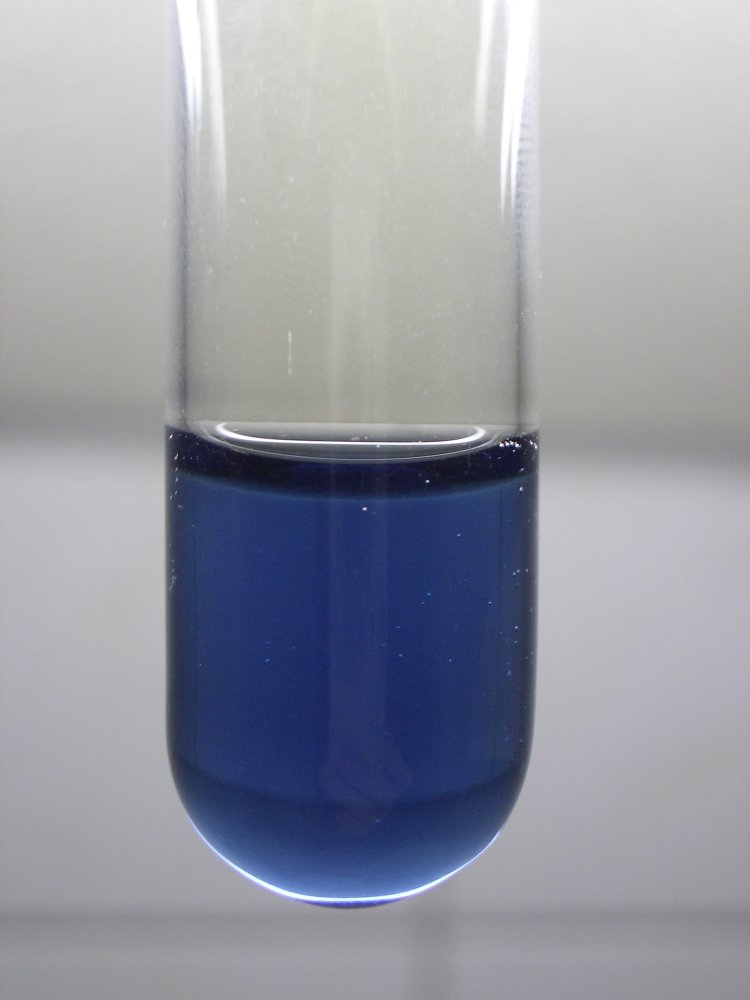
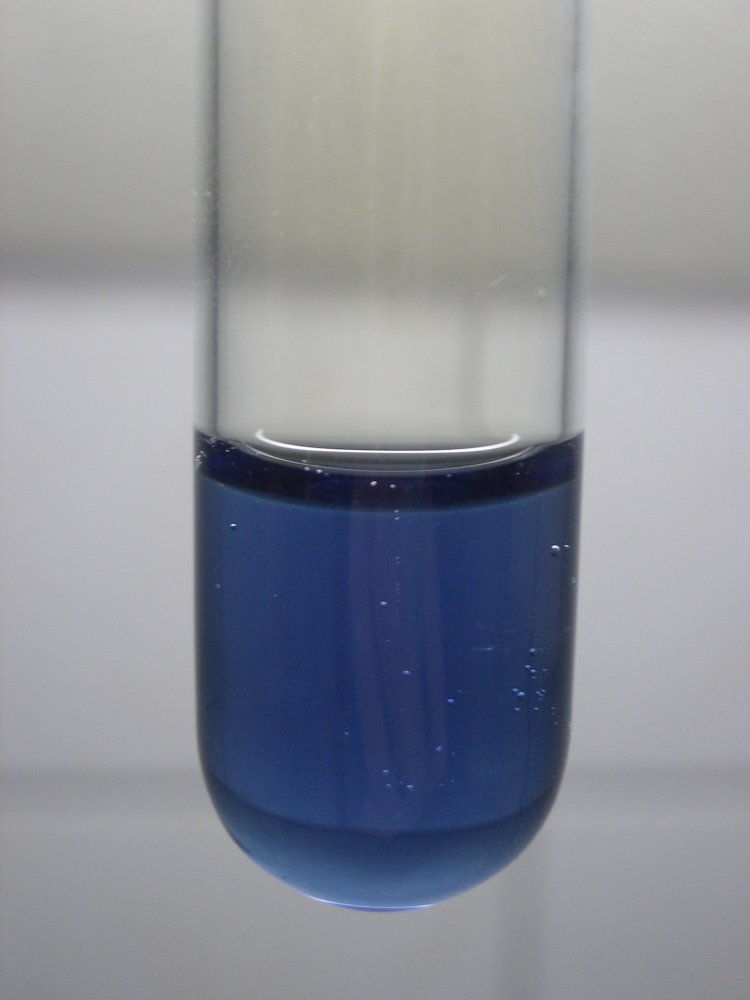
This sequence shows that the blue complex only fades very slowly. The color in the right picture is just a little less intense and a little less brilliant. The differences are minimal though. After this, the liquid was heated to 60° C for approximately one minute. At this elevated temperature, the blue compound quickly decomposes. The original blue color, however, is not obtained anymore. The liquid becomes green. On dilution its color changes to light blue, the color is close to the color of aqueous Cu2+, but it is a little more cyan. After heating and after dilution, the liquid still bubbles very slowly.
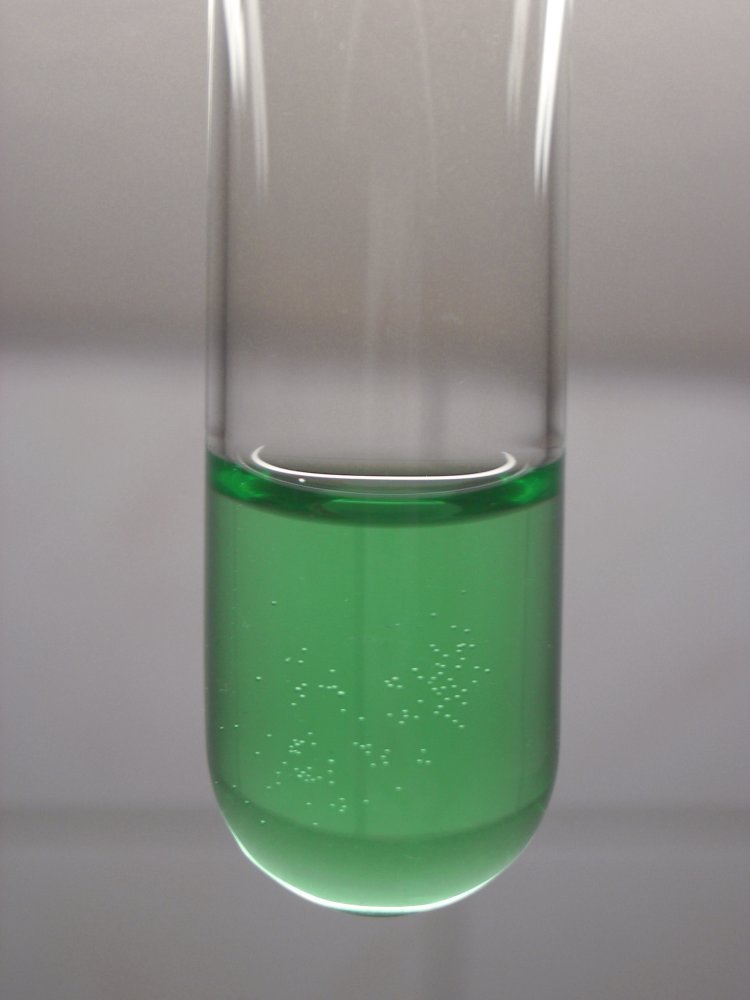
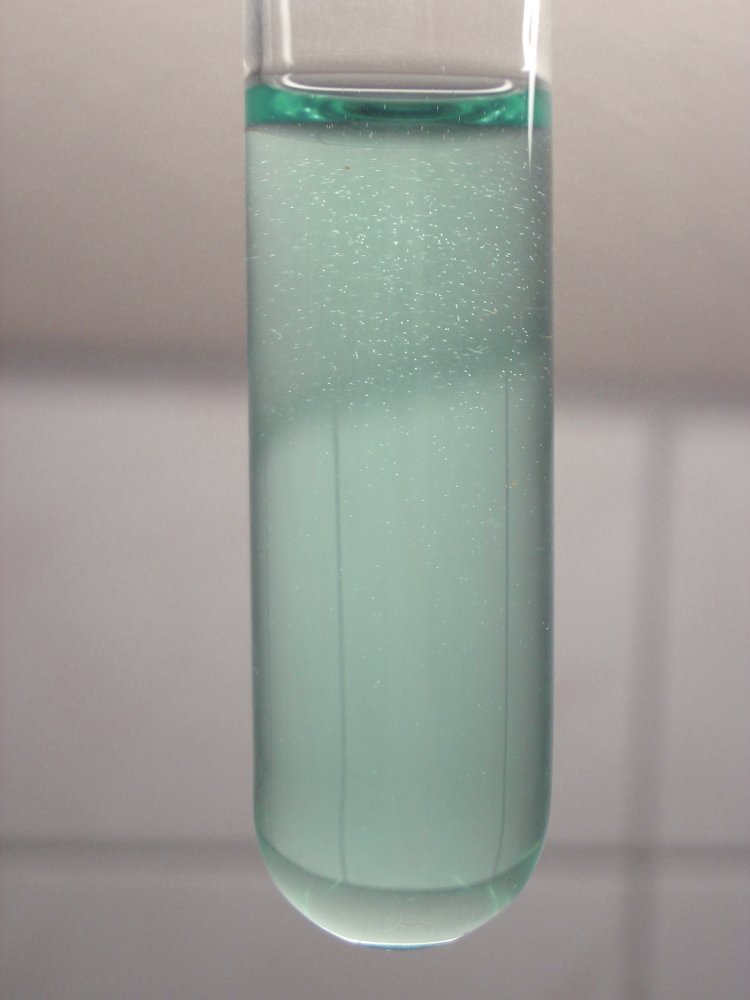
![]()
Discussion of the results
The deep blue coordination complex is only formed when chloride is present, but it does not appear when the concentration of chloride is too high. There is an optimum for the chloride concentration. When the experiments are performed in dilute hydrochloric acid (e.g. 10% HCl), then only a small amount of the blue compound is formed. If concentrated HCl is used, then no blue compound is formed at all on addition of the nitrite. Apparently the formation of tetrachlorocuprate (II) and the formation of the blue coordination complex are competing reactions, where the formation of tetrachlorocuprate (II) is favoured by higher chloride concentrations.
Remark: Instead of using copper sulfate and sodium chloride, one can also use copper (II) chloride. In that case one needs to dissolve some copper (II) chloride in dilute sulphuric acid and then the nitrite has to be added.